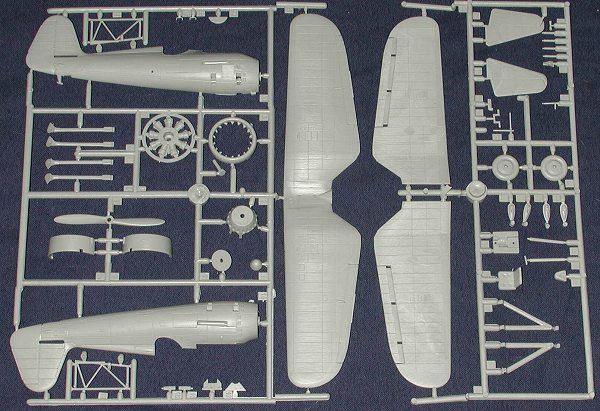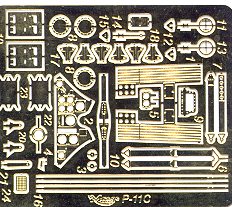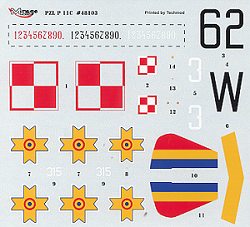
|
KIT: |
Mirage 1/48 PZL P.11c - Rumanian AF |
|
KIT # |
48103 |
|
PRICE: |
$22.98 MSRP |
|
DECALS: |
two aircraft |
|
REVIEWER: |
|
|
NOTES: |
Multimedia kit with etched brass and resin |

|
HISTORY |
I'll let you get most of the historical background from the previous P.11 preview. However, I can add that Pulawski fighters in foreign service also saw combat in WW2. Romanian P.11f and P.11c aircraft were in front line units when Romania supported German thrust into Soviet Union in 1941. The P.11cs were the survivors of the Polish campaign that had flown to Rumania to escape the Germans. They were later impressed into service alongside the Romanian-built P.11fs. As the planes became more obsolete, they were later used as fighter trainers until the end of the war.
|
THE KIT |

Since this has exactly the same plastic as the earlier kit reviewed, I'm going to repeat all that I said about that kit.
This kit has excellent detailing, especially on the corrugated wing. One very nice touch is that the edges of the control surfaces have been molded with a bit of a gap, just like on the real plane. This is the first time I've seen this on a kit and I applaud Mirage for doing so. In terms of the usual things I look for, there are some sink marks on the thicker parts, such as the ends of the wing struts and on a few spots on the fuselage. They appear to be easy to fill. The mold seams are a bit large on some parts and the mating surfaces will need to be properly sanded down to get rid of some very minor irregularities. Again, normal for a short run kit.
 The cockpit is very
complete with framework, seat, stick, rudder pedals and the like. Howe much one
will be able to see through the small opening is conjectural, but at least the
builder will know it is there! In addition to a plethora of small plastic bits,
the kit comes with a very shiny and a bit thicker than normal etched fret. This
includes a number of reinforcement pieces as well as the instrument panel,
seat belts, control surface hinges and other small, fiddly bits. A single resin
piece is provided for the side radiator and it needs to have about half of its
thickness removed before it can be used.
The cockpit is very
complete with framework, seat, stick, rudder pedals and the like. Howe much one
will be able to see through the small opening is conjectural, but at least the
builder will know it is there! In addition to a plethora of small plastic bits,
the kit comes with a very shiny and a bit thicker than normal etched fret. This
includes a number of reinforcement pieces as well as the instrument panel,
seat belts, control surface hinges and other small, fiddly bits. A single resin
piece is provided for the side radiator and it needs to have about half of its
thickness removed before it can be used.
Instructions are quite good and leave no doubt as to what goes where and how it
should look when finished. Color information is given in generic terms and
Humbrol colors. The instructions are on one side of a large sheet with decal and
paint information on the other. It is
 obvious from reading the
instructions that this same sheet is used for all three boxings of the P.11c.
obvious from reading the
instructions that this same sheet is used for all three boxings of the P.11c.
What is different about this kit is the decal sheet. In this case, it is for two planes. The box art plane is from the Rumanian AF circa 1942.It is in the standard Polish colors of khaki uppers and light blue lowers. Unlike the Polish planes, the underside of the fuselage is also light blue. There is a yellow fuselage band and the underside of the wing tips are also yellow. The Polish version sports an experimental camouflage scheme. White 3 has added olive green to the normal scheme and it is in a semi-splinter pattern along the upper surface and fuselage. Though three planes were allegedly painted in experimental colors, this is the only one for which there are any photos. Decals are by Techmod and are superbly done. I'm not exactly sure why they were included, but some small numbers in three colors and distinctive script have been included.
|
CONCLUSIONS |
As with the previous version previewed, this has to be the finest PZL P.11c in any scale and most assuredly the best in 1/48. You may relegate your LTD version to the swap pile or you may want to rob the decals from it!
Review kit courtesy of your editors penchant for interesting aircraft.
If you would like your product reviewed fairly and quickly by a site that has well over 175,000 visitors a month, please contact me or see other details in the Note to Contributors.